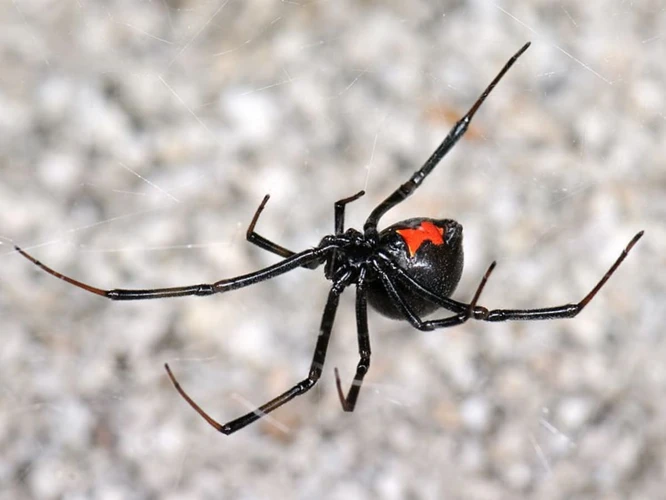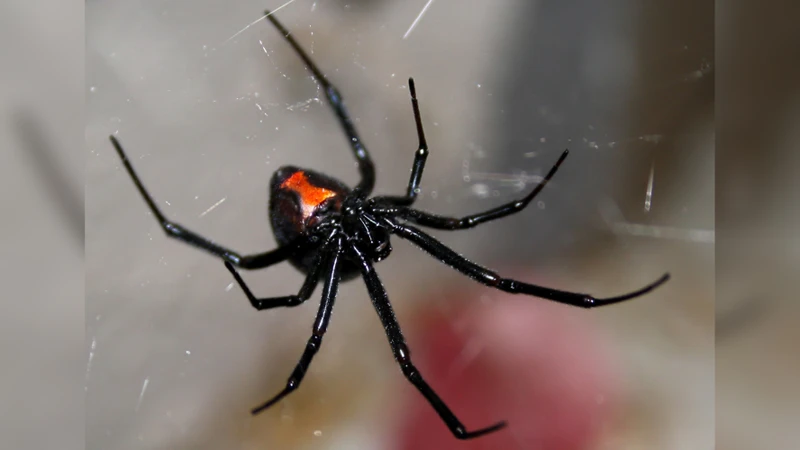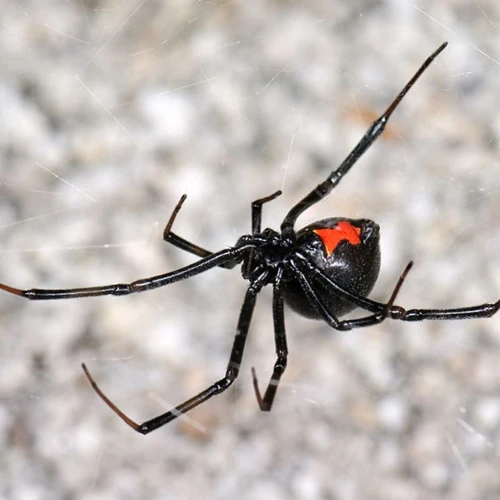As the name suggests, black widow spiders are infamous for their venomous bite and predatory nature. These arachnids are found in different parts of North America and are known for their unique feeding habits. However, have you ever wondered how much these spiders consume in a day? How do they detect their prey and what factors affect their daily diet? In this article, we will explore the feeding behavior of black widow spiders and provide insights into their daily intake. So, let’s unravel the mysteries behind these enigmatic predators.
Black Widow Spider Feeding Habits

The diet of the black widow spider has been a topic of concern and curiosity for many. These predatory arachnids are infamous for their venomous bites and are known to consume a variety of prey. The question of how much they eat in a day, however, remains a mystery to many. In this section, we will delve into the feeding habits of black widow spiders, exploring their diets, frequency of feeding, and factors that affect their daily food intake. We will also discuss their hunting behavior and how they consume their prey. For more information on black widow spider diet variations, survival, hunting, and adaptation, check out the links provided throughout the article.
What Do Black Widow Spiders Eat?
Black widow spiders are known to be cunning predators hunting and feeding on a wide range of prey. They are not finicky eaters and will devour any small creature that they can capture in their web. The diet of black widow spiders mainly consists of insects, but they also eat small animals like lizards, rodents, and even other spiders.
Below is a table showing some of the most common prey of black widow spiders:
| Insects | Small Animals |
|---|---|
| Flies | Lizards |
| Mosquitoes | Rodents |
| Grasshoppers | Scorpions |
| Beetles | Other spiders |
Black widow spiders may also prey on some creatures larger than themselves if they can immobilize them. While the diet of black widow spiders is diverse, it mainly depends on the availability of prey in the environment. Factors like habitat, climate, and temperature can have a significant impact on the number and variety of prey available in a given area.
However, despite the fearsome reputation of their venom, black widow spiders rarely pose a serious threat to humans. You can learn more about the impact of black widow spiders on humans from this article.
How Often Do Black Widow Spiders Eat?
Black widow spiders are known for their ability to go long periods without eating. These spiders can survive for several weeks to months without a single meal. However, their feeding habits can be influenced by various factors, such as the size and species of the spider, environmental conditions, and the availability of prey.
Size and species of the spider: Smaller black widow spiders require less food than their larger counterparts to survive. Different species of black widow spiders also have varying feeding requirements. The specific diet of a black widow spider can be influenced by their location and the diversity of prey in the area.
Environmental factors: Environmental conditions can also affect how often black widow spiders eat. For instance, during colder months, black widow spiders tend to reduce their feeding rates. In contrast, a warm and humid environment provides the perfect conditions for a thriving prey population. This may, in turn, lead to a higher rate of feeding for black widow spiders.
Black widow spiders can survive for relatively long periods without feeding. The frequency at which they feed, however, is influenced by various factors. To learn more about the unique feeding habits and diet of black widow spiders, check out the article on Black Widow Spider Diet and Variations.
How Much Do Black Widow Spiders Eat in a Day?
Black Widow Spiders are known for being venomous and dangerous predators. They consume a wide variety of insect species, which might make one wonder, how much do these spiders eat in a day? The answer is not as straightforward as it seems since the amount of food a black widow spider consumes can vary based on different factors.
The table below outlines the daily intake of black widow spiders based on different factors.
| Factors | Amount of Food Consumed Daily |
|---|---|
| Size and species of the spider | Varies, but can range from 1 to 12 insects a day |
| Environmental Factors | Varies, but can range from 1 to 5 insects a day |
As mentioned in the previous section, the size and species of the black widow spider can impact its daily food intake. Larger spiders tend to consume more insects than smaller ones. Similarly, a female black widow spider may consume more than a male spider due to its larger size.
Additionally, environmental factors such as temperature, humidity, and prey availability can impact the amount of food a black widow spider consumes. In areas where insects are abundant, these spiders may consume more than in areas where insects are scarce.
It is important to note that black widow spiders do not need to eat every day. Their metabolism is slow, so they can survive for long periods without food. However, when they do consume prey, they tend to eat enough to last them for several days.
The amount of food a black widow spider consumes in a day can vary based on different factors such as size, species, and environmental conditions. While they do not need to eat every day, they tend to consume enough to last them for several days. To learn more about the hunting and survival techniques of black widow spiders, check out our article on black widow spiders survival.
Factors Affecting Black Widow Spider’s Daily Diet

The amount and type of food that a black widow spider eats each day depends on various factors. These factors can include the spider’s size and species, as well as the environmental conditions that it lives in. Additionally, black widow spider feeding habits and behaviors may also play a role in how much they eat each day. Understanding these factors can provide valuable insight into the life cycle and survival of these fascinating creatures. To learn more about black widow spider diet, you may want to check out our detailed article on their diet.
Size and Species of the Spider
The size and species of a Black Widow Spider can greatly influence how much they eat in a day. As different species of Black Widows come in different sizes, it can also affect the size of their prey. Some species, such as the Southern Black Widow, can grow up to an inch in length, making them relatively larger than other species like the Western Black Widow, which typically grows up to 0.7 inches in length.
A larger spider means that it requires more food to sustain its energy levels, so they may consume more in a day than their smaller counterparts. Size also impacts the amount of venom a Black Widow can inject into its prey. Larger black widows inject more venom than smaller ones, making it easier for them to immobilize larger prey.
Additionally, factors such as the spider’s gender and age can also influence their daily food intake. Female Black Widows require more food to support their reproductive activity; hence, they tend to consume more food than males. Juveniles also require more food relative to their body size since they’re still developing.
The availability of food in their environment can affect the quantity of food a Black Widow Spider eats in a day. If food is scarce, they might eat less or go for longer periods without feeding. They may also adapt their diet to fit the available prey, resulting in a fluctuation in the amount of food consumed daily.
Although the Black Widow Spider’s diet mainly consists of insects and other small invertebrates, the amount consumed in a day varies depending on the spider’s size, age, species, and availability of food in their habitat. Understanding these various factors can provide us with insights into the feeding habits of these venomous spiders and their hunger pangs.
Environmental Factors
Environmental factors can also play a significant role in a black widow spider’s daily diet. These spiders can be found in many different environments, including deserts, forests, and grasslands, and their prey availability can vary depending on their location.
Temperature: Temperature is one of the most important environmental factors that can affect a black widow spider’s feeding habits. These spiders are cold-blooded and cannot regulate their own body temperature. They rely on the external environment to maintain their body temperature. At colder temperatures, black widow spiders become sluggish and are less likely to hunt for food. They may not consume as much prey during the colder months.
Humidity: Humidity can also play an important role in a black widow spider’s feeding habits. These spiders require a certain level of moisture in the air to survive. In dry environments, prey may be scarce, and black widow spiders may not have enough to eat. In very humid areas, on the other hand, there may be an overabundance of prey, and black widow spiders may eat more than they need to.
Predators: Predators can also have an impact on a black widow spider’s feeding habits. These spiders are solitary hunters and rely on stealth and ambush to catch their prey. If there are a lot of predators in the area, such as birds, lizards, or other spiders, black widow spiders may be less active and consume less food as they try to avoid becoming prey themselves.
Environmental factors can also have indirect effects on a black widow spider’s feeding habits. For example, if there is a drought or a wildfire in an area, this can disrupt the local ecosystem and cause changes in the prey availability for black widow spiders.
Understanding the environmental factors that affect black widow spiders can give us insight into their feeding habits and help us understand more about these fascinating creatures.
Black Widow Spider Feeding Behavior
As one of the most venomous spiders in the world, the black widow spider has unique feeding behavior that sets it apart from other arachnids. Their feeding habits are fascinating, especially when it comes to how they detect and consume their prey. In this section, we will explore the feeding behavior of black widow spiders, including the mechanisms they use to hunt for food and how they take it down. Additionally, we will delve into their solitary hunting behavior and compare the diets of male and female black widow spiders. Keep reading to learn more!
How Black Widow Spiders Detect Prey?
Black Widow Spiders are known for their ability to detect prey in their surroundings. They use their sense of touch, taste, and vibration to detect potential prey.
Vibration Detection: Black Widow Spiders have specialized hairs on their legs that detect vibrations in their environment. When prey is nearby, the vibrations caused by their movement trigger the spider’s sensory hairs, alerting them to the potential food source.
Sense of Touch: Black Widow Spiders have a great sense of touch that allows them to feel the air currents around them. This helps them detect the movements of their prey.
Sense of Taste: Black Widow Spiders also have chemoreceptors on their legs and pedipalps that allow them to taste their prey. This helps them differentiate between potential food sources and non-food items.
Black Widow Spiders are not known to be active hunters. They tend to wait in their webs for prey to come to them and may use the above-mentioned senses to detect prey that comes in contact with their webs. The black widow spiders are known for their solitary lifestyle and their diet including mostly small insects.
These incredible creatures have an array of senses at their disposal to detect prey in their environment, and this helps them to survive and thrive. If you want to learn more about Black Widow Spider’s feeding behaviors, you can read our other articles on /black-widow-spiders-hunt-solo/, /male-female-black-widow-diet/.
How Do Black Widow Spiders Consume Their Prey?
Black Widow Spiders are known for their unique feeding behavior. After capturing their prey, they use their sharp fangs to inject a venomous saliva into the insect’s body, allowing it to be easily consumed. Here’s a closer look at how these spiders consume their prey:
| Step | Process |
|---|---|
| Step 1 | First, the spider wraps its prey in a cocoon of silk to immobilize it. |
| Step 2 | Next, it bites its prey, injecting a potent neurotoxin that quickly paralyzes its victim. |
| Step 3 | The spider then uses its sharp fangs to shred the insect’s exoskeleton and begins to suck out its bodily fluids. The digestive juices in the spider’s saliva break down the insect’s internal organs, turning them into a liquid that is easy to consume. |
| Step 4 | Finally, the spider completely consumes its prey, leaving behind only the empty exoskeleton. |
This behavior may seem gruesome, but it’s essential for the spider’s survival. Black Widow Spiders have a high metabolism and require a lot of protein to survive. Their venom allows them to effectively capture and consume their prey in a relatively short amount of time.
It’s interesting to note that while Black Widow Spiders are typically known as passive hunters, waiting for prey to come to them, some species actually actively hunt for their food. To learn more about this behavior, check out our article about Black Widow Spiders who actively hunt for their prey.
Conclusion
In conclusion, black widow spiders are fascinating creatures with unique feeding habits. They are known for their ability to catch and consume a variety of insect prey, who they capture using their sticky webs. While the frequency and amount of food they consume in a day may vary depending on various factors, such as their size and the environmental conditions they are in, it is generally agreed they eat relatively small amounts each day.
Additionally, black widow spiders have adapted in unique ways to ensure their survival, such as their ability to detect prey through vibrations and chemical cues. Once they catch their prey, they use their strong jaws and potent venom to subdue and consume it. While black widow spiders may not be the most beloved creatures, their feeding habits and behavior are certainly worth studying and appreciating.
It is important to note that black widow spiders can be dangerous to humans, and it is best to avoid them and their webs as much as possible. If you suspect you have been bitten by one, seek medical attention immediately. Overall, black widow spiders play an important role in our ecosystem and serve as an interesting subject of scientific study.
Frequently Asked Questions
What is the diet of black widow spiders?
Black widow spiders mostly feed on insects, such as flies, mosquitoes, grasshoppers, and beetles. They also occasionally eat other spiders and small vertebrates like lizards and rodents.
How often do black widow spiders eat?
Black widow spiders can go for several days and up to several weeks without food. However, they typically eat once every few days if prey is abundant.
How much do black widow spiders eat in a day?
Black widow spiders can eat a significant amount in a single sitting if they haven’t fed in a while. However, on average, they consume about 2-5 prey items per day.
Does the size of a black widow spider affect its diet?
Yes, the size of a black widow spider affects its diet. Larger spiders can consume larger prey, including insects, small animals, and even other spiders.
Do environmental factors affect the diet of black widow spiders?
Yes, environmental factors can affect the diet of black widow spiders. In areas with less prey availability, they may eat less frequently or consume a wider variety of food sources.
How do black widow spiders detect their prey?
Black widow spiders detect their prey through vibrations in their webs or on surfaces near their resting areas. They also have well-developed eyesight and can see the movement of potential prey.
What happens during the feeding process of black widow spiders?
When a black widow spider captures its prey, it will inject venom to subdue the prey and immobilize it. Once the prey is immobilized, the spider will wrap it in silk and begin the feeding process by sucking the fluids out of the prey’s body.
Do black widow spiders consume their prey entirely?
Black widow spiders typically consume most of their prey, leaving behind only the exoskeleton. However, they may not consume prey that is too large for them to handle or if they are interrupted during the feeding process.
Can black widow spiders survive without food for extended periods of time?
Yes, black widow spiders can survive for weeks without food if necessary. They will slow down their metabolism to conserve energy until they can find their next meal.
Are black widow spiders harmful to humans?
While black widow spiders can be venomous and potentially harmful to humans, they typically will not bite unless they feel threatened. If you suspect you have been bitten by a black widow spider, seek medical attention immediately.






